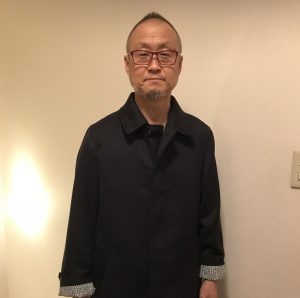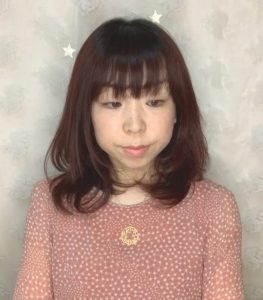#23ゲスト:齋藤泰子先生
The Guest of April :Ms. Yasuko Saito
今月のゲスト:齋藤泰子先生
ジャンル:キルト作家
Profile:
1982年パッチワークを始める。
1989年ハーツ&ハンズに転入。
キルト日本展ほか、国内外のキルト展にて受賞歴多数。
2001年より「ヴォーグキルト塾」講師を務め、後進の指導に当たる。
また布のデザイン「じゃぱねすく泰子」を手掛けるなど、多方面で活躍。
(https://www.tezukuritown.com/nv/c/cf1103527/より引用)
- 日本コンテンポラリーキルト協会(JCQA) 会長
- 泰子キルトスタジオ 主宰
- 齋藤泰子クラス「和布わぁるど」 日本ヴォーグ社(コロナ禍のため2021年3月にてクローズ)
- 一般社団法人「日本キルト協会」理事
This month’s guest: Ms. Yasuko Saito
Genre: Quilt Designer
Profile:
1982 Ms. Yasuko started patchwork.
1989 Entered into Hearts and Hands.
Winner of many awards at National and International Quilt Exhibitions, including the Quilt Japan Exhibition.
Since 2001, she has been an instructor at Vogue Quilt School, where she teaches younger students. She is also active in many fields, such as designing fabrics for “Japanesque Yasuko.
(https://www.tezukuritown.com/nv/c/cf1103527/より引用)– available in English Translation
- Chairman of Japan Contemporary Quilt Association (JCQA)
- CEO of Yasuko Quilt Studio
- Yasuko Saito’s class “Wanuno World” Nippon Vogue – (Cloth Handmade Bags & Accessories)
- One of the directors Japan Quilt Society
作品
インタビュー音声
Q.キルトを始められたきっかけはどのようなことからだったのでしょうか。
私生活ではお嫁さんとして、姑が48歳、舅が50いくつだったかな。そこに24歳の私がお嫁に行ったんです。夫は3つ上で、その家には未婚の次男三男と次女がいたんですね。そういった中で生活をするとなると、女中さんみたいなことをすることになるんですよ。そういった意味では結構しっかり自分を持っていたんです。 それで、割となんでも自分でできてしまうタイプだったんです。簡単に諦めないし、やる以上はちゃんとやる。そういった生活の中で、私は結構体育会系だったのでバレーボールをやっていたんですが、これを始めたのはそういった封建的な生活の空気から逃げ出したかったのもありました。けど元夫はこれにあまり賛成はしなかったんですね。雨戸も締め切って、私を入れない音がするんです。それくらい厳しい家だったんです。―ええ!まるでドラマのようですね…。
こういう話をすると「先生小説書いた方がいいよ」とか言われるんですよ。でもね、こういう経験は全てプラスです。 それで、質問の最初に戻りますが、バレーボール部員が最初はポシェットを持っていて、自転車で通り過ぎたんですよ。それがなんだか配色の赤が遠くからでもすごく目立っていたんですよ。私は色に興味があるので、何を背負っているのかなと思って、その人に聞いてみたら「パッチワーク」だって言われたんですね。 だけど私縫い物も嫌いだったし…。正直最初、自分からはやりたくないなと思いました。それで、最初にポシェットを持っていたその方はパッチワークを実際に習っていて、私を紹介してくれると言ってくれて。それで実際習い始めてみて、実際自分でもできると思って作ってみるんですけど、なんか色が濁って見えるなあ…と。全然綺麗に見えなくて。ものすごく色の配色を考えたのに、うまくできない。なんで!?と思って、悔しくて2枚目も作ったんですけど、最初と同じ。透明感もなくてゴミを集めたみたいになってしまったんです。じゃあ3枚目と思ってやってみてもそれも同じ。―なぜなんでしょうか?
明度と彩度。自分でこれが原因だなあってわかったのは、要は最初自分の好きな色や配色で決めるじゃないですか。結構私澄み切った色が好きなのにうまくいかなくて、そこですごく挫折感を味わったんですね。簡単に答えが出せなくて悔しいなあと思って…。そこから本格的に習い始めました。 それでその時、夫が1000万の不渡を受けてたんですよ。昭和49年で1000万の不渡って言ったら大変な金額ですし、その時に私もお金の苦労を経験したわけなんですけど、どうにか仕事をしてこの逆行から抜け出さないとお金が得られない。そこで何がいいだろうかと思ったんですが…。 私は日本舞踊をやっていたんですよ。だからやっぱり綺麗なお仕事がしたい。どうにか綺麗な仕事をして、生活をクリアにしたかったんです。私には3人の子供がいるんですが、下の子がまだオムツしてた頃の話なので、働きに行くことも中々できなかったんです。パートっていう言葉もなかった。そんな中で「着物に携わるお仕事」。どんな職種かもわからないけど、今のどん底の気持ちの中でもちょっとだけ夢があるかなあと思ったんですね。 それで、近所に2件、そういうお仕事がある場所があったので、そこへ「私を雇っていただけませんか」って面接にもいきました。だけど断られ。でも生活がかかっているので背に腹はかえられないじゃないですか。あとは分厚い電話帳に載っている50件近くの番号にかけて、全部断られ続けて…。最後の3件くらい残った内の1件で「お会いしましょう」って言ってくれたんです。 それで、展示会を確かうちの家で最初やったのかな?100坪あってお部屋数も多かったので。―つまり、先生のお家でお着物の反物を展示して、見に来られた方が気に入ったものがあればそこで購入していただくという感じでしょうか。
そうです。それで、売り上げから5分(5パーセント)の儲けだったんですね。買ってくれると思わないしひたすら私は生活のためって言うその考えをちゃんと持ってるから、浮かれないんですよ。その中で、私のところに入ったのが10,000円だったんですよ。売れたのが高い反物だったんだと思うんですが。内職して10円単位の時代だから、それがとてもとてもありがたいことで。 当時、パッチワークと関連があるんだけど、呉服は呉服屋さんによっては、お金の値札をつけたまま歩かせている呉服屋さんもいたんです。つまり、着物も帯も何でもかんでも高い物を売りつけて、個性も何も関係なしに。私はそういうことが大嫌いだったんです。着る人の雰囲気を壊さないということは、その人に一番ピタッと合うということなので、半襟から着物から帯とか帯揚げとか一切合切、もう本当にに長くやってくださったお客様が、美容院で褒められたと。配色がとても素敵だって言われたのを聞かせてもらったんだけども、それは半襟とか帯揚げとかの色が少しでも合わないと、ちょっと待ってねって言って、数社を自分で探し出します。お客さんに合う、お客さんが喜んでくださるものを見つけたいので。―すごくよくわかります。だから色にすごくこだわりもあるし、それは自分だけじゃなくて例えばそれを纏う人が合うか合わないかっていうのが大事ですもんね。
そうです。もちろん高く売りつけたらそれだけ儲かるけど、個性も何も見ずに売りつけるなんていかがなものかと思いますし、自分としてはそういうことはしたくありませんでした。 それが今もパッチワークの配色と似通ってきている気持ちですね。Q.できれば先生がデザインされた生地のお話も伺いたいです。
まず、元々私は小学校上がる頃から書道やってたから、筆の質感が面白いなと思って。 そもそもこういったデザインをしたのは、当時日本の生地には私が希望する色がなかったんですよ。欲しい欲しいって言ったら、じゃあ作ってみたら?っていう話になって、実際に作ってみたわけです。 動線が好きなんですよ、動く線。好きなんだけど、キルトに動く線を使う日本の作家さんっていうのがいなかったんですよね。こんなの今まで日本にはなかったね!って言って、すごく良いって言ってくれる人もいたし、私がね1番正確に見るには、コンクールの作品に私の生地を使っているものが出てきたのは3年後でした。しかも、大きな柄のデザインだったけど作品にはほんの少し。それでも自分がデザインした生地だからわかるんですよ。その時、自分の生地で作ってくれるようになったんだーと思って嬉しかったですね。イベント
〇第1回東京キルトショー
期間 2022年3月25日(金)~28日(月)
AM10:00~18:00
最終日17:00で終了
場所 東京・TOC五反田メッセ
主催 一般社団法人日本キルト協会
情報はこちらへ
https://jqsevent.com/
〇SAQA-Japan展示:
5月13日(金)~25日(水)
場所:ジェーナス クリエイション
“スタジオ・アート・キルト・アソシエーツ-SAQA”という団体がアメリカの世界的な大きなキルト団体としてあるんですね。そこでSAQA in Japanっていうのが去年の1月に結成したんです。
日本の布の歴史
日本の染織は長い歴史に渡り、身に纏う事が発端で、「生誕と死」は産着と死装束(しにしょうぞく)・士農工商の身分の差・老若男女・富豪と貧困・冠婚葬祭の儀式・など様々な状況に置かれ、育まれた日本伝統民族衣装の着物類、日本は北から南へと長い地形により四季の春夏秋冬の季節の移ろいにも、又 金銭を得る幾多の商売にも、身を纏う衣装は、様々に変化する。
北国の冬の季節には藍染の分厚い生地に刺し子で更に、地厚く縫って防寒の役目と傷んだ箇所に当て布を足し、その上から刺し子手法は補強の役目も有る。実にその土地土地に合った、自然に発生する日本民族衣装には古(いにしえ)の知恵が有って、現在に至ります。
又、綿毛・麻・芭蕉(バナナの樹皮)から糸を繰り、蚕から絹糸、などが布になり、人民は質素な暮らし方から、次第に豊かな暮らしになり、際立って魚の鰊で財を成した鰊御殿に暮らす人の衣装は贅を尽くした、豪華な立派な着物は財を見せびらかすもので有った。
婚礼の花嫁衣装には、3枚襲(さんまいかさね)と言い、柄は3枚共通柄や関連図柄で、肌に近い白地には婚家の作法に染まるよう白地に淡色の配色で梅柄(例:松竹梅)が描かれ、中の着物は赤地に竹柄(例:松竹梅)、一番外側には黒地に、(お引きずりといって座った時に足が見えない様に、豪華な贅を尽くした柄を見せるように、足元にグルッと広げる)その家が代々栄えるような図柄、緑色の老松(例:松竹梅)の配色など描かれます。
娘が結婚後の家で肩身の狭い思いをしないよう、親が大金を出して結婚支度を揃える親心に、きらびやかな反面、切なくなります。時代時代に合った、手の込んだ、素材・手描きの技量・刺繍や金粉素材を駆使する着物には、美的センスに驚嘆をし、息をのみます。私的には、それらは美術品として後世に残して置きたいと願います。
齋藤先生の語録
手で出来る事に対して、出来ない、って事は無いと思っています。 簡単には行きませんが、制作を重ねていけば、必ず出来るようになります。 ご自分の持っている才覚を信じ、進む方向へは、好きか嫌いかを択し、好きな方向へ行く事が個性を出すことで、作り続ける事が、ご自分の目指す方向へ向かいます。 他人の事は関係ない、良い方向へ行きたいならば、ご自分の好きに、何枚も作りなさい。 夢はニューヨークですが、財務的には心配しないで、私自身常に興味を持ちつつな事柄を色々経験し、堪能し、その中から概念を破るような何か新しいモノを掴み取りたい。何事も、やってみなければ分からない。モダンな古民家・ホテル・コンクリートむき出しの壁面・海外へも、全作品を展示し、販売したいですね。齋藤泰子先生の作品の紹介 1999年以前
作品のタイトルは平家物語の冒頭部に「祇園精舎の鐘の声 諸行無上の響きあり」盛者必衰の理(ことわり)をあらわす。意味は「この世のすべての現象は絶えず変化していくものだ」という響きがある。それを表現した。齋藤泰子先生の作品の紹介 MOVEMENT #24
MOVEMENT#24の作品は、ドイツに嫁ぐ娘の結婚を、母親が密かに幸せを願う作品です。
齋藤泰子先生の作品の紹介 MOVEMENT #91 Zen-1
キルトナショナル ’21 入選作
全面、手漉き和紙が土台のキルトです。土台の紙質は布とは違う硬い素材ですから、キルテイングが上手く出来るかどうか、はドキドキしましたね。皺にもならず、出来ました。
齋藤先生オリジナルの生地
60種類の齋藤泰子のオリジナル生地を作りました。作品に欲しい色・鉛筆や筆で描いたデザインは、「こういうものが欲しい」の気持ちが原点になっています。Q.How did you get started making quilts?
When I was 24 years old, I married a man who was 3 years older than me. His mother was 48 and his father was 50. There were also two younger boys and a younger sister in the family. Living in this situation, I had to do work in the home – -similar to a maid. I had a strong sense of self. I developed quite a strong spirit to endure such a difficult situation. I was the type of person who could do everything by myself and I don’t give up easily. If I do it, I do it right! I was a pretty athletic person, so I played volleyball. Maybe, I wanted to escape from that feudalistic family atmosphere of life, even for a very short time. But, my ex-husband was not supportive of this. When I returned home, he closed all shutters and doors and I was not able to enter into the home easily. It was a really tough situation living in a strict household.Oh my. It’s like a drama.
When I talk about these things, people say, “You should write a novel, teacher!” But, you know, I think these tough experiences made me more positive. Well… going back to your original question. One of my volleyball team members had a “pochette” (translating from French as a small slender shoulder purse) as she rode by on her bike. When I saw her, there was something about the “pochette” red color scheme that really stood out from a distance. I am very interested in colors, so I wondered what she was carrying and when I asked…she told me it was “patchwork!” I thought, “Wow, so this is what patchwork is!” But, I didn’t even like sewing at that time. To be honest with you, I didn’t even want to try to make patchwork, and I quit at the beginning. But then, she introduced me to her class, which gives lessons in how to make a quilt. I decided to give it a try. I thought that it would be easy to make. But, mine didn’t look beautiful at all to me. I carefully planned the color scheme. But, I wasn’t able to do well and I couldn’t get it right. Why? I was so disappointed and frustrated that I tried to make a 2nd one. But the result was same. Then, I decided to make a 3rd quilt. But, it was not good either.But…Why is that?
I would say, “Brightness, saturation and color intensity.” What I realized was that, this was the cause of the problem. Since I made it with my favorite colors only, my quilt did not give the color images as I intended. Then, I felt frustrated because I couldn’t get it right. I couldn’t find an easy answer, so that is when I decided to seriously learn how to make a quilt. At this same time, my ex-husband had a financial default of ten million. In 1974, 10 million was a very large sum of money. I, too, experienced this financial hardship and I realized I had to somehow work to earn money by myself. I considered my options… When I was young, I was doing Japanese classical dance. That’s why I wanted to do a job that would be beautiful. At this time, I have three children and my youngest child was still in a diaper. Since I was so disappointed and wanted to have some small hope – – a dream to work with something beautiful – – I wanted to do work related to the Kimono! So…I went to two shops in my neighborhood that had Kimono jobs, and I went there for interviews, asking if they would hire me. But, it was not so easy to hire a woman with children. They turned me down. I needed to earn money and my life depended on it. I looked in a very thick telephone book and called nearly 50 numbers of Kimono shops. Continuously, I had been turned down. Finally, one of the last three shops gave me a chance. This Kimono shop dealer met me and gave me an answer right away. At the time, I was actually living in a home with an area of about 3,000 sq.ft. – – which was quite big and very spacious in Japan. It had a lot of tatami rooms. Thankfully, I then exhibited and displayed KIMONO fabrics in my home due to its large size!―Wow! So in other words, you displayed Kimono fabrics at your home – – and if friends and visitors in town like what they see, then they can purchase Kimono fabrics right away?
Yes, that’s right! I made 5 % percent profit from all sales. I earned JPY 10,000.- at that time, which was a really good amount. I had high priced pieces of fabric that sold. In those days, when you worked for a company – – you might earn JPY10.00 to assemble something at home. I was very, very grateful! Some drapers (KIMONO shops) wanted to sell very, very expensive fabrics to the customers with no regard to individuality. But, I did not like that kind of thing. So after 20 years, I decided to retire from that job and start my own business. At this time, it was related to patchwork… I really wanted to propose fabric designs that fit the customer, that matched their personality, and that the customer would be happy with! For each persons’ individual Kimono, I selected every detailed piece from the HANERI (a detachable neckpiece for kimonos) to the OBIAGE (a long, thin piece of fabric used to secure an obi pillow to the body to give a 3-dimensional shape to an obi knot). My customer said… she was so happy! She said that she was praised by her beauty salon friends for the color selections of her kimono. I am so good at finding the most perfect colored fabrics for each person. I always want to find something that my customers will love!I understand very well. That is why you are so interested in colors. You know that it is so important for your customers to wear colors that suit them best.
Yes, it is! Of course, if you sell at a high price, you can make a lot of money – – but, selling without looking at their individuality or anything else is not a good idea…And, I do not want to do that! That is how I feel now, similar to the color scheme of my patchwork. Maybe, my color scheme was based on my experiences with Kimonos at that time.Q. Well now, I would like to hear about all about the new fabrics you designed.
Originally, I had been doing calligraphy since I was in elementary school。 I found the texture of the brush interesting and designed with such lines. Sometimes I design a pattern smaller and color them myself. On other fabrics, I do the design and then the colors are directed by me – again separately. The reason why I started designing this way was because at the time, there were no Japanese fabrics in the colors and designs I wanted. I said, “I want it!” And they said, “Why don’t you make it?” So…I actually made it! I like a flowing line – a moving line, but there were no Japanese quilter artists who used such a design in their quilts. Some people who saw my designs praised it and were very complimentary! “There has never been anything like this in Japan before!” After 3 years, I saw my fabric used in a competition work, which won in the contest. I was so happy to see a fabric that I designed, even if it was only a small part of the work. I was so delighted that they started to use my fabrics to make products!Forthcoming Event
First Tokyo Quilt Show
DATE: March 25th ~28th, 2022
TIME: 10:00 ~ 18:00
(28th ~ Closes at 17:00 on the last day)
PLACE: Tokyo TOC Gotanda Messe
Sponsored by Japan Quilt Association
The directors of this association are all quilters.
For information, please click here:
https://jqsevent.com/
SAQA-Japan Exposition
DATE: May 13th ~ 25th, 2022
PLACE: JANUS CREATION
SAQA: Studio Art Quilt Association (USA)
2021 Jan. SAQA Japan was established.
The History of Japanese Fabrics
The dyeing and weaving of fabrics in Japanese culture has a long history. It began with creating clothing to wear in both birth and death. Starting with the clothing of “Ubugi,” which is traditionally the first kimono for a newborn baby as presented by the mother. While the “Shinishouzoku,” is the Japanese burial garment used when a person departs for the other world transition into Heaven. Kimonos are traditional Japanese costumes that were created for various situations and transformed depending upon the social class. “SHI-NOU-KOU-SHO” – a so called classification status. The status differences were between samurai, farmers, artisans and merchants, young and old, rich and poor, weddings, funerals and ceremonies. Noting that the traditional Japanese national costume is the kimono. Costumes (kimonos) also changed with the changing seasons, and with the many businesses that had more wealth. In the northern winter season, thick indigo-dyed fabrics are sewn with a SASHIKO, and the cloth is sewn thick to protect against the cold and to reinforce any damaged parts of the fabric. Each Japanese costume or kimono, which is suited to each land region and naturally occurs, has the wisdom of ancient times and continues to the present day.
Reference: “Shi-no-ko-sho” was a social order of four
divisions under the Tokugawa era.
SHI : Samurai
NOU: Peasants
KOU: Craftsmen
SHOU: Merchant
In addition, threads were also weaved from fluff, hemp, and basho (banana bark). The silk threads are created from silk moths, weaved into cloth. People of the region gradually became wealthy from their simple life style. Such as those who lived in the Herring Palace, where they made their fortune from “herring,” the most prominent fish. They wore extravagant and luxurious kimonos, which were used to show off their fortune and great wealth!
The bridal costume or kimono for a wedding has its origins in the wedding ceremonies of Samurai society. The motif is a common pattern or a related design on (3) three pieces of clothing. On the first layer, which is close to the skin, the base color is White. The background can be painted (dyed) with a light-colored plum pattern on a white background to match the customs of the wedding household. The middle kimono or the second layer is Red with a bamboo pattern and the outermost kimono layer is Black with a design that will allow the family to prosper for generations to come. This pattern is a green color scheme with old pine trees on Black silk fabric (plum, bamboo and pine). Also of great importance is the length of the Black outer layer. It must spread out around the feet so that the legs are not visible when sitting – – showing a gorgeous and luxurious pattern. As the bride walks on the tatami mat, the fabrics flow.
The patterns called SHO-CHIKU-BAI – – together make up the harmonious symbol of “good luck,” which symbolizes longevity, life and the future, along with hope.
SHO : PINE TREE
CHIKU : BAMBOO TREE
BAI : JAPANESE PLUM TREE
The parents’ willingness to spend a large sum of money for their daughter’s gorgeous wedding kimono is so that she will not feel confined to the house after the wedding. This avoids their daughter from feeling ashamed in the married family after marriage. This is both glamorous and sad, which can make us feel a bit of pity.
We marvel and gasp at the aesthetic sense of the kimono, with its elaborate use of materials, hand-painted techniques, embroidery, and gold-powder materials – – all in keeping with the times of each unique period! We personally hope that these kimonos will be preserved as magnificent works of art for posterity!
Ms. Yasuko Saito Sensei’s Words…
I don’t think there is anything that CAN’T be done by hand! It is not easy, but if you keep creating, you WILL be able to do it! Believe in your own talent, and decide whether you like it or not and is it in the direction you want to go. It is a choice, and going in the direction you like is the way to express your individuality. And…by continuing to make it – – you will be heading in the direction YOU want to go. If you want to go in the right direction, do not listen to others’ opinions and make as many pieces as you want! My dream is to be in New York, but don’t worry about finances! I am interested in experiencing and enjoying a variety of subjects that break concepts! I want to grasp something new and exciting! I want to try everything! You will never know unless you try. Modern old houses, hotels, bare concrete walls – – I would like to exhibit and sell all of my works on the walls and abroad!Introduction of Ms. Yasuko SAITO Sensei’s work (from 1999)
The title of this work is taken from the beginning of the “Tale of the Heike.” The sound of the bell at Gion Seisha (Monastery) echoes the endless cycle of actions, “which expresses the principle of the inevitable decline of the prosperous. The ever changing nature of all things – – all that flourishes must fade. The meaning is that all phenomena in this world are constantly changing. This is the expression. The arrogant do not prevail for long.Introduction of Ms. Yasuko SAITO Sensei’s works MOVEMENT #24
The work in MOVEMENT #24 is about a mother secretly wishing happiness to her daughter who is getting married in Germany.
Introduction of Ms. Yasuko Saito Sensei’s work MOVEMENT #91 Zen-1
Quilt National ’21 winning work – Honorable Mention
The entire surface of this quilt is based on handmade Japanese paper. I was nervous about whether I would be able to quilt it well, because the base paper is a hard material different from cloth. I was thrilled to see it turned out fine without wrinkles!
Ms. Yasuko Saito Sensei’s Original Fabrics
Sixty types of Yasuko Saito’s original fabrics were created. The colors, pencils and brushstroke designs that I want for my work originate from the feeling of “this is what I want.”If you are interested in…
http://quilt.sakura.ne.jp/shop/shop_top.html
これからもいろいろな分野での第一人者の方、新進気鋭の芸術家の方、ファッション、いろいろな分野の方たちのインタビューを配信させていただきます。
We will continue to deliver compelling interviews with the leading creative artists and influencers in various fields such as art, fashion, cooking, etc…
We hope you’ll be looking forward to many more exciting and interesting creative updates soon!




































